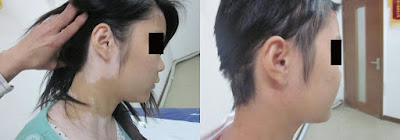Vitiligo is a continual and long-term skin problem that produces patches of
white depigmentation that develop and enlarge in certain sections of the
skin.
Segmental or focal: White patches tend to be smaller and appear in one or a few areas. When vitiligo appears in a focal or segmental pattern, it tends to stay in one area one side of the body. Many times it continues for a year or so, then stops. It also progresses slower than generalized vitiligo.
Non-segmental or generalized: Widespread white patches appear symmetrically on both sides of the body. This is the most common pattern and can affect pigment cells anywhere on the body. If often starts and stops many times over the course of a person’s lifetime. There’s no way to determine when, if, or how fast patches will develop.
One study showed that 75 percent of people with vitiligo have loss of pigment on the hands and face. Other common areas are in body folds, like the skin under your arms and around your groin.
Vitiligo commonly affects body folds (such as armpits), places that have been injured in the past, and areas exposed to sun, around moles, or around body openings. It can also affect eyelids and hair.
Segmental or focal: White patches tend to be smaller and appear in one or a few areas. When vitiligo appears in a focal or segmental pattern, it tends to stay in one area one side of the body. Many times it continues for a year or so, then stops. It also progresses slower than generalized vitiligo.
Non-segmental or generalized: Widespread white patches appear symmetrically on both sides of the body. This is the most common pattern and can affect pigment cells anywhere on the body. If often starts and stops many times over the course of a person’s lifetime. There’s no way to determine when, if, or how fast patches will develop.
One study showed that 75 percent of people with vitiligo have loss of pigment on the hands and face. Other common areas are in body folds, like the skin under your arms and around your groin.
Vitiligo commonly affects body folds (such as armpits), places that have been injured in the past, and areas exposed to sun, around moles, or around body openings. It can also affect eyelids and hair.





